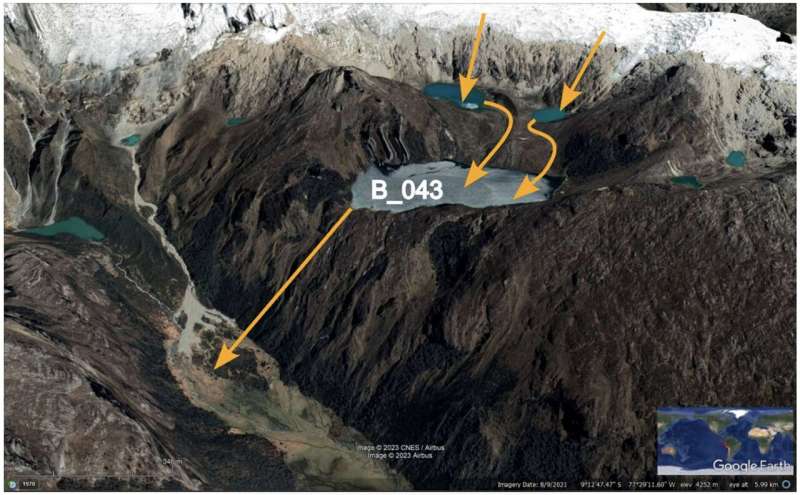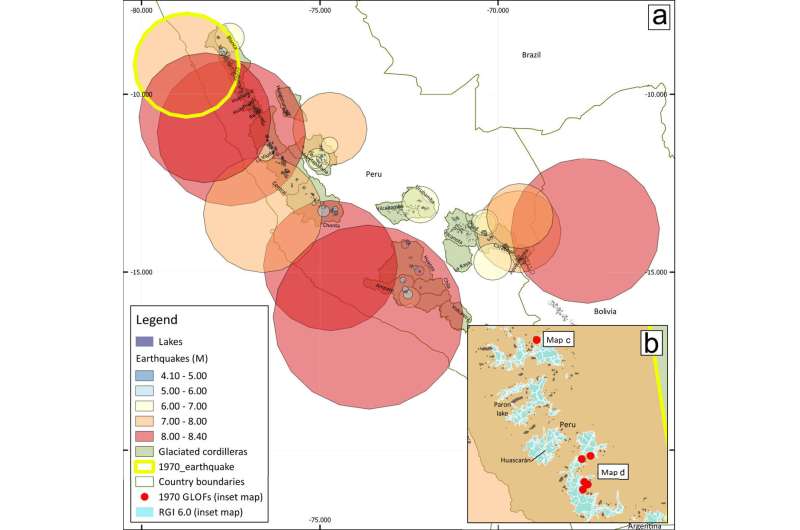April 11, 2024 feature
This article has been reviewed according to Science X's editorial process and policies. Editors have highlighted the following attributes while ensuring the content's credibility:
fact-checked
peer-reviewed publication
trusted source
proofread
Earthquakes may not be primary driver of glacial lake outburst floods

Glacial lakes form when meltwater is trapped behind a dam, usually glacial ice, bedrock or a type of moraine (terminal types being an unconsolidated pile of debris at the maximum extent of the glacier). When a dam fails, the resulting sudden release of a large volume of water is known as an outburst flood, having catastrophic consequences on the environment and communities downstream. Such events are seemingly becoming more common as glaciers retreat and meltwater accumulates in larger and more numerous glacial lakes, due to climate change.
Oftentimes, the ground shaking from earthquakes has been associated with triggering glacial lake outbursts by disrupting the integrity of the dam. The seismic activity can also trigger destabilization of surrounding slopes, resulting in avalanches of rock debris that displaces water in the dam and overtops it. However, a new study published in Geophysical Research Letters suggests that this may not be the case and triggering processes could be much more complicated.
Dr. Joanne Wood, a Postdoctoral Research Fellow at the University of Exeter, and colleagues investigated glacial lakes in the tropical Peruvian and Bolivian Andes, South America, and the record of outburst events associated with earthquakes. They found that of 59 earthquakes occurring between 1900 and 2021 near glacial lakes, only one resulted in an outburst flood.
Reflecting on the current global record for glacial lake outbursts triggered by earthquakes, Dr. Wood states that only 11 can be confidently linked to this association (occurring in Peru, Nepal and Switzerland), six of which are associated with a single magnitude 7.9 earthquake in May 1970 in the Cordillera Blanca mountain range of Peru, which destabilized predominantly moraine-dammed lakes.
Clearly, despite the intuitive link between seismic activity destabilizing dams to cause catastrophic floods, the local Andes and global evidence so far does not empirically support the assumption.
To test this further, the research team used the United States Geological Survey Catalog to identify 11,733 earthquakes of magnitude >4 and 67 temporally known glacial lake outburst floods since the beginning of 1900. These flood events were then split into four categories to determine if there was a temporal lag from a seismic trigger by assessing if they occurred on the same day as an earthquake, within a month, within six months or within a year.
The scientists used this dataset to investigate four processes associated with earthquakes and why these did not trigger glacial lake outburst floods (except for the 1970 anomaly):

- Landslides triggering moraine overtopping: For the 1970 event, five out of the six outburst floods were triggered by mass movements, but Dr. Wood and colleagues suggest that the smaller size of glacial lakes may mean that this does not cause water displacement as much as it would in blocking a river system, for example.
- Shaking disturbs moraines: Seismic body waves (P and S waves traveling through Earth's inner layers) dissipate as they reach valley floors where glacier lakes occur, while surface waves may be blocked by some types of topography. Reduced shaking reaching moraines means they are less likely to collapse, and small movements may even be beneficial to reduce porosity and permeability to increase stability.
- Liquefaction: Loosely consolidated and water saturated sediments are susceptible to liquefaction, whereby the ground surface loses strength and overlying structures sink into it. Vulnerable sediments are comprised of course silt, fine sand and gravel, which are all generally smaller than the constituents of dam-forming moraines.
- Faulting: Glacier lake dams tend not to have major faults running through them to initiate points of failure and drainage, and if faults do intersect the lake, they tend to not be expressed at the surface.
Considering the 1970 anomaly once more, Dr. Wood and colleagues suggest that this earthquake triggered thousands of rockfalls, rockslides and soilslides into lakes across three valleys comprised of deeply weathered granitoids that had been destabilized by frost wedging. This is the process by which water flows into cracks, freezes and causes expansion, thus opening the crack further.
Beyond the water displacement theory and these being mostly moraine-dammed lakes instead of bedrock-dammed, like the rest of the Peruvian lakes, is precisely why the 1970 event was so catastrophic in terms of glacial lake outburst floods requires further investigation.
However, this research is important as it challenges the conception of earthquakes as the major driver of glacial lake outburst floods, and suggests that more research needs to be conducted to determine the primary driver (potentially permafrost and structural geology) in order to help hazard assessments mitigate against the impacts on the local environment, infrastructure and communities.
More information: Joanne L. Wood et al, Shaking up Assumptions: Earthquakes Have Rarely Triggered Andean Glacier Lake Outburst Floods, Geophysical Research Letters (2024). DOI: 10.1029/2023GL105578
Journal information: Geophysical Research Letters
© 2024 Science X Network



















